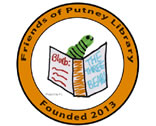Friends of Putney Library talk on the restored 1654 Roehampton Mounting block and Milestones around Putney
|
'From London Towne to Portsedown they saye tis myls three score....' begins an inscription on the Roehampton Mounting Block.

Well before the construction of the wooden Putney Bridge in 1729, travellers relied on milestones to mark important routes and measure their journey. Some were in the form of a mounting block to assist people mounting and dismounting a horse or cart, especially women, the young, the elderly or the infirm, and would have been considered an important local amenity.
An ordinance of 12th April 1654 decreed that local surveyors of roads be appointed by constables and churchwardens in every parish. Thomas Nuthall of Roehampton was appointed for his local parish and in 1654 appears to have decided to mark his appointment by voluntarily setting up a combined mounting block and milestone on Kingston Road, Putney Vale.The first report we have of it is an article in 'The Gentleman's Magazine' in 1787.
Over the years the Roehampton block has disappeared, been rediscovered and moved to many different sites. Tracing its history means that it can now be re-instated in or near its original position. There are carved inscriptions on each side of the stone which can still be deciphered.
Come and hear the fascinating story of the detective work surrounding the Roehampton Mounting Block and Milestones around Putney in an illustrated talk by Phil Evison.

A Friends of Putney Library free event.
Wednesday 24th April, Putney Library 6pm-7.30pm
Free entry, but you are advised to book a ticket in advance from the library by calling 020 8780 3085 or by email to Charlene.coleman@gll.org.
“Putney is an ancient place but there are few existing relics of its past. You may be interested
in these particulars of one of its few authentic antiquities." Ernest Dixon - 1928.
March 27, 2019